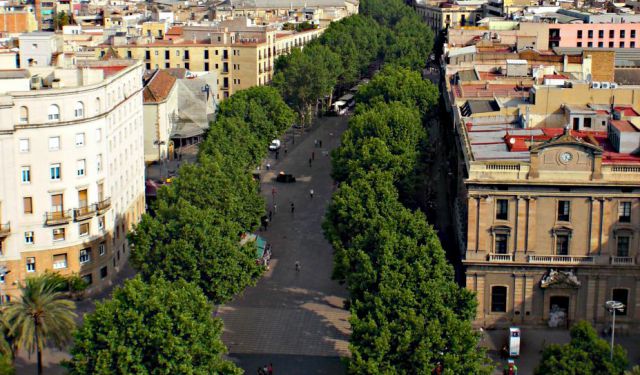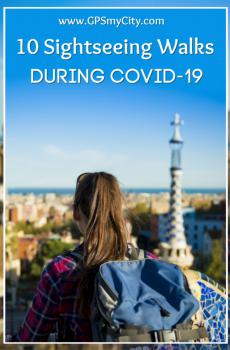
Placa de Catalunya (Catalonia Square), Barcelona
Catalonia Square, a meeting place between the historic Old Town and the modern upscale Eixample district of Barcelona, is rightfully considered the city's central point. Several of Barcelona’s main arteries converge here, such as Gràcia Boulevard, La Rambla, Rambla de Catalunya, and the Angel's Gate, making it a significant urban hub. Covering approximately 50,000 square meters, the square is known for its fountains, statues, and numerous pigeons.
Catalonia Square began to take shape after the medieval city walls were demolished in the 19th century, starting its initial development in 1902. Further urbanization occurred in 1929 for the Barcelona International Exposition, based on designs by architect Francesc de Paula Nebot. During the Spanish Civil War in the 1930s, the square witnessed some key moments in Barcelona’s history, including the so-called May Days, a series of clashes between 3 and 8 May 1937 during which factions on the Republican side of the Spanish Civil War engaged one another in street battles.
Today, the square is home to several prominent sculptures such as “Deessa” by Josep Clarà and “Pastor de Pau” by Pablo Gargallo, along with a monument dedicated to Catalan politician Francesc Macià.
The Barcelona Telephone Exchange, situated nearby, features stained glass windows by artist Brian Clarke, created in 1991 to celebrate the 1992 Olympic Games. The underground mosaics were designed by students of Massana School.
Although historically Catalonia Square has hosted various theaters, none of them remains today. Similarly, many of the famous cafes that once attracted writers and artists disappeared during the Spanish Civil War. Café Zurich is one of the few surviving establishments. Presently, the square is surrounded by shopping centers like El Corte Inglés, FNAC, and El Triangle, as well as several hotels.
As a major transportation hub, Catalonia Square connects different parts of the city through its extensive above-ground and underground networks, making it an essential point for locals and tourists alike.
Tip:
While the fountains are beautiful during the day, make sure to witness their display at night when they come alive with alternating colored lights.
Catalonia Square began to take shape after the medieval city walls were demolished in the 19th century, starting its initial development in 1902. Further urbanization occurred in 1929 for the Barcelona International Exposition, based on designs by architect Francesc de Paula Nebot. During the Spanish Civil War in the 1930s, the square witnessed some key moments in Barcelona’s history, including the so-called May Days, a series of clashes between 3 and 8 May 1937 during which factions on the Republican side of the Spanish Civil War engaged one another in street battles.
Today, the square is home to several prominent sculptures such as “Deessa” by Josep Clarà and “Pastor de Pau” by Pablo Gargallo, along with a monument dedicated to Catalan politician Francesc Macià.
The Barcelona Telephone Exchange, situated nearby, features stained glass windows by artist Brian Clarke, created in 1991 to celebrate the 1992 Olympic Games. The underground mosaics were designed by students of Massana School.
Although historically Catalonia Square has hosted various theaters, none of them remains today. Similarly, many of the famous cafes that once attracted writers and artists disappeared during the Spanish Civil War. Café Zurich is one of the few surviving establishments. Presently, the square is surrounded by shopping centers like El Corte Inglés, FNAC, and El Triangle, as well as several hotels.
As a major transportation hub, Catalonia Square connects different parts of the city through its extensive above-ground and underground networks, making it an essential point for locals and tourists alike.
Tip:
While the fountains are beautiful during the day, make sure to witness their display at night when they come alive with alternating colored lights.
Want to visit this sight? Check out these Self-Guided Walking Tours in Barcelona. Alternatively, you can download the mobile app "GPSmyCity: Walks in 1K+ Cities" from Apple App Store or Google Play Store. The app turns your mobile device to a personal tour guide and it works offline, so no data plan is needed when traveling abroad.
Placa de Catalunya (Catalonia Square) on Map
Sight Name: Placa de Catalunya (Catalonia Square)
Sight Location: Barcelona, Spain (See walking tours in Barcelona)
Sight Type: Attraction/Landmark
Guide(s) Containing This Sight:
Sight Location: Barcelona, Spain (See walking tours in Barcelona)
Sight Type: Attraction/Landmark
Guide(s) Containing This Sight:
Walking Tours in Barcelona, Spain
Create Your Own Walk in Barcelona
Creating your own self-guided walk in Barcelona is easy and fun. Choose the city attractions that you want to see and a walk route map will be created just for you. You can even set your hotel as the start point of the walk.
Barcelona Introduction Walking Tour
According to legend, Barcelona was founded by the mythological Greek hero Hercules on one of his expeditions, when a storm hit his boats. The first eight boats managed to escape without damage, but the ninth was lost at sea. Hercules found his lost friends some days later on the coast, all safe and sound. The boat's crew, taken by the beauty of the coastal landscape, decided to stay. On that... view more
Tour Duration: 3 Hour(s)
Travel Distance: 5.7 Km or 3.5 Miles
Tour Duration: 3 Hour(s)
Travel Distance: 5.7 Km or 3.5 Miles
Picasso's Barcelona Walking Tour
Pablo Picasso – the great Spanish painter and sculptor – developed his style in Barcelona where he spent the formative years of his life, from the ages of 14 to 23. It is said that when the master spoke nostalgically of home, he actually meant the Catalonian capital, despite having been born in Malaga.
This self-guided walk will take you to the Picasso Museum, the bar-restaurant and the art... view more
Tour Duration: 2 Hour(s)
Travel Distance: 4.2 Km or 2.6 Miles
This self-guided walk will take you to the Picasso Museum, the bar-restaurant and the art... view more
Tour Duration: 2 Hour(s)
Travel Distance: 4.2 Km or 2.6 Miles
La Ribera Walking Tour
La Ribera is a culturally rich, historic area of Barcelona’s Old Town; somewhat less touristy than the Gothic Quarter (which one should really visit as well) and quite unspoiled, authentic and pretty. Centuries ago, it was a very well-to-do neighborhood inhabited by aristocrats, merchants, wealthy sailors, and Jewish money-lenders. Today, it is regarded as the Soho of Barcelona – a popular... view more
Tour Duration: 2 Hour(s)
Travel Distance: 2.8 Km or 1.7 Miles
Tour Duration: 2 Hour(s)
Travel Distance: 2.8 Km or 1.7 Miles
La Rambla Walking Tour
One of the main streets in central Barcelona, La Rambla is popular with tourists and locals alike. Connecting the city’s old port with Plaça de Catalunya, it is filled with cultural and historic landmarks, as well as many terraces, restaurants, shops and street artists. Spanish poet, Federico García Lorca once said it was “the only street in the world which I wish never ended.”
Start... view more
Tour Duration: 1 Hour(s)
Travel Distance: 2.3 Km or 1.4 Miles
Start... view more
Tour Duration: 1 Hour(s)
Travel Distance: 2.3 Km or 1.4 Miles
Gothic Quarter Walking Tour
A walk through the Gothic Quarter – Barcelona’s oldest part, dating from the Roman era – is like a journey through time. The typical Roman grid plan is still visible in the quarter's layout. Only a few roads are open for car traffic, so there is little in the way of enjoying the narrow, atmospheric streets filled with high-quality architecture, numerous boutiques, and coffee shops.... view more
Tour Duration: 2 Hour(s)
Travel Distance: 1.8 Km or 1.1 Miles
Tour Duration: 2 Hour(s)
Travel Distance: 1.8 Km or 1.1 Miles
Montjuic Walking Tour
Montjuic is a hill in Barcelona which offers a variety of great attractions of historic, cultural, and architectural value. Here, you can watch a spectacular water show at the Magic Fountain of Montjuic, visit the place where matadors faced the bulls in the past, and explore the ancient Montjuic Castle with its breathtaking views.
A convenient start point, Placa d'Espanya is the second... view more
Tour Duration: 3 Hour(s)
Travel Distance: 5.0 Km or 3.1 Miles
A convenient start point, Placa d'Espanya is the second... view more
Tour Duration: 3 Hour(s)
Travel Distance: 5.0 Km or 3.1 Miles
Useful Travel Guides for Planning Your Trip
10 Sightseeing Walks During Covid-19
Borders closed, flights canceled. As countries across the globe scrambling to curb the spread of coronavirus, it is nearly impossible to travel these days. For those with wanderlust at heart, living without exploring is a really tough challenge.
But even in times of hardship like this, one should...
Top 10 Spanish Foods and Drinks to Try in Barcelona
In the countries like Spain, food is a national heritage and cultural attraction in its own right. The latter is even more true of Catalonia in general and Barcelona in particular. Presented here are the 10 staples of Catalan food tradition, missing which would be a gastronomical...
Barcelona Souvenir Shopping: 17 Uniquely Spanish Things to Buy
Spain, in general, and Barcelona, in particular, are a treasure trove of all things exciting. Set your foot in Barcelona and you'll be spoiled for the choice of things worth trying and taking home. Before your head starts spinning, check this guide out to put yourself in the right...









